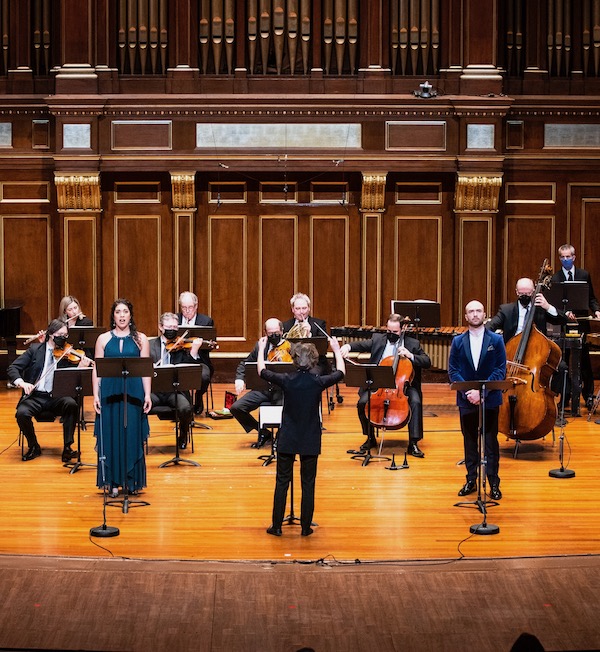Boston Symphony Chamber Players revisit the cantata with Gandolfi premiere

Michael Gandolfi’s Cantata, Where can I go from your spirit? received its world premiere by the Boston Symphony Chamber Players with soloists Sophia Burgos and John Brancy, led by conductor Anna Rakitina Sunday at Jordan Hall. Photo: Robert Torres
While the cantata is no longer a vogueish genre, fresh takes on the old form are always welcome. So, credit is due to Michael Gandolfi for Cantata, Where can I go from your spirit? This thirty-minute meditation on finding solace in the face of suffering received its world premiere Sunday afternoon at Jordan Hall courtesy of the Boston Symphony Chamber Players.
Gandolfi wrote Cantata for BSO principal oboe John Ferrillo and in memory of Ferrillo’s friend and colleague, oboist Laura Ahlbeck (Ahlbeck died of a rare degenerative brain condition in 2015). At Ferrillo’s request, it sets Psalm 139, one of several scriptural passages he read to Ahlbeck during her illness, presented here in a new paraphrase by the Chicago-based poet Jill Peláez Baumgaertner.
Scored for solo soprano and baritone plus chamber ensemble, Cantata’s three connected sections chart a dialogue between the soprano, representing “a person in life,” and the baritone (the voice of an authoritative, but caring, God). Carefree days lead to unexpected tragedy; at the end comes illumination and a tentative kind of peace.
Gandolfi’s writing in the work is typically fluent and colorful. Though the instrumental ensemble consists of just ten players, the sonic palette is expansive. From the first gesture— spaced series of punchy chords that resolve into a lyrical sequence colored by delicate percussion and harp flourishes”—one senses they’re in knowing hands.
Much of what follows is bright, lyrical, and diatonic. The vocal lines are consistently natural and comfortable, both in terms of register and phrasing. Granted, at times—like during the concluding refrain of Part 2 – they straddle the line between concert and popular (or cinematic) idioms a bit closely. Even so, the cantata’s texts always come across clearly.
Gandolfi’s facility with the ensemble is likewise ear-catching. Sometimes, his orchestration is astonishingly busy: at the climax of Part 1, strings and winds bracket the vocal lines in florid waves of arpeggios. Yet rather than distracting from the singers, the effect frames their words in cascading aureoles.
There are also moments of subtler beauty, like the glowing low-string chord sequence towards the beginning and the lovely oboe obbligato in Part 2. The work’s closing chords, which echo the opening theme from a distance, are haunting.
Taken together, there’s much to admire in this affecting, ultimately life-affirming score. That said, the music’s tonal radiance and general lack of sustained harmonic pungency sometimes undermines the narrative’s dramatic trajectory, especially over its latter half. In Bach cantatas, revelation and transcendence are generally gained through hard-won musical effort. Here they seem to be received as a matter of course, minus a commensurate struggle or conflict. Accordingly, on Sunday, the coda of Cantata offered only partial catharsis. As with many Gandolfi works, his excellent technique and ear for sonority are often done in by lightweight ideas.
Nevertheless, Sunday’s performance, led by BSO assistant conductor Anna Rakitina, was smartly played and sung.
Soprano Sophia Burgos sang with luminous tone, even projection, and terrific enunciation of her texts. So did baritone John Brancy, whose stentorian presence displayed suppleness and warmth.
Rakitina’s direction ensured that the ensemble was cleanly balanced. Oboist Ferrillo’s solos, as well as turns from harpist Jessica Zhou and percussionist Timothy Genis, were among the highlights.
Clarity, energy, and color also marked the afternoon’s other selections, Belá Bartók’s Contrasts and Antonín Dvořák’s G-major String Quintet.
As presented by clarinetist William R. Hudgins, violinist Haldan Martinson, and pianist Vivian Choi, Bartók’s 1938 trio was characterized by playfulness, personality, and pathos as required. While the outer movements were defined by snappy rhythms and lusty cadenzas, the central “Pihenő” unfolded with icy clarity.
Dvořák’s op. 77 Quintet, on the other hand, was all warmth and soul. Most striking were the exchanges between violinist Martinson and cellist Blaise Déjardin, who throughout seemed engaged in a friendly competition to see who could play more beautifully.
The larger group—which included violinist Alexander Velinzon, violist Steven Ansell, and bassist Edwin Barker—displayed a gripping unity of ensemble. Their various exchanges in the Andante were spotless. Though the Scherzo was a few ticks slower than a true Allegro vivace, the first movement overflowed with spirit and the finale danced characterfully.
The Boston Symphony Chamber Players play music by Paul Hindemith, Yehudi Wyner, and Mozart at 3 p.m. February 20 at Jordan Hall. bso.org
Posted in Performances